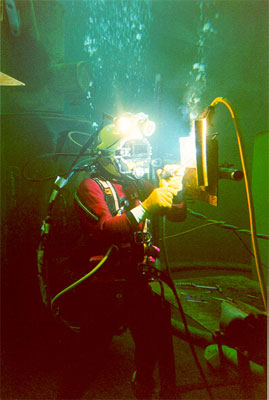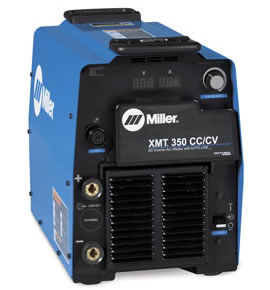Executive Summary
- XMT inverters provide power and consistency in a portable package.
- Auto-Line™ power management technology helps ensure a consistently-steady arc and allows for any input voltage hook-up with no manual linking.
- XMT 456 used extensively for hydro-arc gouging (carbon arc gouging with water instead of air).
- XMT 350 weighs only 80 lb. and can be shipped as luggage with members of the crew to ensure that they get to work immediately upon arrival on site.
20,000 Welds Under The Sea
World-jumping from places like Rio to Curacao sounds like out of a spy movie. It’s actually just another day at work for the underwater welding pros at Miami Diver, Inc. of Miami, Fla. Miami Diver and its partners in the SubSea Solutions Alliance specialize in the underwater inspection, maintenance and repair of deep sea vessels. The company has pioneered methods that make it the most highly-qualified underwater welding outfit in the world.
Traveling at a moment’s notice to any port in the world means its equipment needs to be compact enough to travel easy and must be able to plug into input power anywhere in the world without sacrificing performance. Miami Diver has found that The XMT® 350 and XMT 456 multi-process inverters from Miller Electric Mfg. Co. provide the power and consistency in a small enough package to meet both of those demands.
Setting Standards for Underwater Welding
Underwater welding can be done in either a wet or dry environment – and Miami Diver excels at both. Wet welding involves using the power source’s stick capabilities with a special underwater electrode (Hydroweld FSTM). The special flux that covers the electrode provides enough protection to lay a weld to code specifications even in water. Dry underwater welding involves installing a coffer dam or hyperbaric chamber around the spot of the repair and pumping it dry. This allows a welder to make the repair in dry conditions.
Welding repairs to large ocean liners and oil platforms are a fact of life for shipping companies that operate on the high seas. But the cost in time, expense and lost revenue is too high for the ship or platform to travel to a dry dock each time it needs repair. Miami Diver serves these companies by coming to them whenever underwater welds are needed.
 |
|
Miami Diver specializes in repairing deep sea vessels and breaks its operation down into three aspects: inspection, maintenance and repair.
|
“We only work on deep sea vessels,” says Kevin Peters, president, Miami Diver. “Our operation breaks down into three aspects: inspection, maintenance and repair. When you get into the high-end repair, that’s where we really excel. And that includes the fact that we’re the only company to date with an A-class wet weld procedure in accordance with D3.6 code.”
The repairs Peters refers to are held to AWS standards under code D3.6, which is broken down into four classes: A, B, C and O. In addition to AWS codes, each welding procedure is dictated by shipping societies throughout the world – none of which would approve wet welding on a ship as a permanent fix. Every weld was considered temporary and resulted in a “condition” being placed on the ship. A condition meant that the weld must be replaced permanently when the ship arrived in dry dock. Ships are not granted new charters if there is a condition placed on it.
Working with Hydroweld and Miller’s XMT inverters, Miami Diver and its partners in SubSea Solutions were able to create approved procedures for Class A welds – “intended to be suitable for applications and design stresses comparable to their conventional surface welding counterparts by virtue of specifying comparable properties and testing requirements” – that are considered permanent. The ship does not need to return to dry dock for a more suitable repair and all conditions are lifted. This advance saves shipping companies exorbitant amounts of money, and Miami Diver counts on Miller’s XMT inverters to provide the weld consistency and quality to pull it all off.
XMT 350 with Auto-Line™ Anchors Underwater Weld Procedure
The bulk of Miami Diver’s underwater welding involves fillet welds on mild steel plate ranging in thickness form 1/4- to 1-in. Mild steel is required in underwater applications because of its low carbon content (anything with a carbon content over .4 percent will lead to hydrogen cracking underwater). Procedures include hull repair, stern seal replacement, bow thruster removal/replacement, propeller blade change-outs, etc.
The wet weldability of the materials to be welded is determined the carbon equivalent (CE). The generally accepted upper limit is 0.4 percent as calculated from chemical or ladle analysis using either the long or shorter formula as detailed in the AWS D3.6M:1999.
Where the CE is outside the upper limit, then other options may be considered, such as using a coffer dam or hyperbaric chamber. In this case, the coffer dam is wet welded to the side of the ship, then dewatered to provide a dry environment for the welders.
In either case, the power source is located above water and is controlled by an operator stationed with the machine. Divers wear a helmet that is connected to the surface that provides air and communications with the operator and fellow divers. They descend with their welding/gouging leads and go to work.
This process provides numerous challenges:
- Input power changes throughout the world. Miami Diver has burned up machines after plugging into higher voltage than older machines could handle.
- Dirty input power (excessive equipment starting/running off of same power source) causes fluctuations.
- The distance between where the machine is plugged into input power and where the final weld is taking place can sometimes be extremely long due to worksite conditions and depth underneath the water, leading to power fluctuations.
- The inherent danger of running an electricity-based procedure underwater.
 |
|
The XMT® 350 multi-process inverter with Auto-Line enables Miami Diver to plug into any power source anywhere in the world.
|
The XMT 350 inverter feature Miller’s exclusive Auto-Line™ technology. The Auto-Line power management technology allows for any input voltage hook-up (208 to 575 V) with no manual linking required. Auto-Line uses a boost converter to boost primary power to a higher voltage. That voltage then charges a capacitor that stores and distributes the energy evenly and guarantees a consistent arc throughout the welding process.
“We use very long cables,” explains Peters. “Some of them are 200 feet by the time you reach the dive site. So wherever it is on the ship, you might have to string a cable a long distance. And to have a consistent current at the end of that rod, that’s the main (benefit).”
“In comparison to a standard diesel-driven DC unit, (the XMTs) give you a 25-percent edge as far as quality of the weld,” claims Peters. “It makes a good welder a great welder and a mediocre one a good welder. The stability that we get from it is the main thing. Fluctuations, for a welder on the surface, may not be an issue because he’ll just long or short arc it. But underwater, it is critical because you must maintain a certain distance.”
The steady arc makes it easier for the welder and results in a better weld with less clean-up/rework. XMT 350 inverters also draw 25 percent less power at rated output than competitive 350-amp inverters. All of these efficiencies provide time and cost savings for Peters and his crews.
“It’s the inverter technology,” he claims, “that really makes the big difference.”
The XMT 456 also plays a key role in Miami Diver’s underwater maintenance and repair. Using a process called Hydro-arc gouging (carbon arc gouging with water instead of air) Peters and his crews are able to cut, remove and repair damaged pieces underwater with the same precision as on the surface.
“The underwater carbon arc gouging (Hydro-arc gouging) we do is actually quite critical because we are now able to remove the weld itself underwater and, with some grinding, put it back up. Whereas traditional cutting equipment for underwater is quite messy and you will end up with a jagged edge that you can’t weld back up.”
Safety is also an issue with welding underwater – electricity and water don’t mix. To ensure the safety of his divers, Peters has outfitted the XMTs with Miller’s RHC-14 hand control. This option controls the current and contactor remotely so that the surface operator can cut the current as soon as the diver requests it.
“You have to break the current when you change a rod,” explains Peters. “So you want to make it cold. The remote boxes shut that unit down internally to where you don’t get any electricity out of the amps. It’s very convenient. Then the diver tells him he’s ready, he flips the switch and now he’s back welding.”
International Partners Solve International Access, Service Problems
In addition to the benefits of the inverters and Auto-Line technology, Peters and his welders count on the small size of the XMT inverters to help them get in and out of foreign customs quickly and with minimal hassle. The XMT 350 weighs only 80 lb. and can be shipped as luggage with members of the crew to ensure that they get to work immediately upon arrival at the site.
“In some of these countries, it’s almost like court to get the equipment out of customs,” says Peters. “But you can fly with any number of bags as long as they are less than 100 lb. So our welders are never separated from their machines. It’s the response time. We can travel on a flight and actually go to work on arrival.”
Peters also relies on the service he gets from Miller and TriGas representative Manny Rosales. While he acknowledges that other manufacturers may offer similar equipment and other dealers may offer similar service, Peters claims he only gets the right combination of the two from Miller and TriGas. The fact that both providers are international companies with partners throughout the world – just like Miami Diver – doesn’t hurt, either.
“Service is the whole thing for us, really,” says Peters. “Our business is such that we may have all of our machines up. We’ve had machines in Tahiti for four months and other machines on the Queen Mary for months as it goes from Montevideo to San Francisco and then Hawaii. What happens is that all of that equipment is out and I need a machine. He (Rosales) will get me a machine if I have to have one today. We’re also very abusive. When you fly around with them like that it’s very tough. But Miller is very responsive. And Manny gets a hold of me and we get the problem solved.”
“It’s a 24-hour clock with these ships,” concludes Peters, “and they are obviously in different time zones throughout the world. So we work with people that we like.”